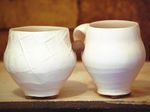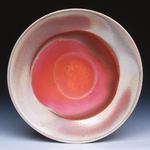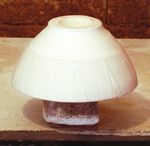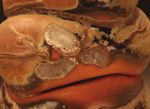FIRING: WADDING by Simon Levin - Ceramic Arts Network
←
→
Page content transcription
If your browser does not render page correctly, please read the page content below
WOOD
FIRING: WADDING by Simon Levin
As artists who wood fire, we are more
observers of phenomena than scientists
who quantify and measure. We hedge
our bets. We try to repeat effects while
remaining open to serendipity. We
have chosen a process fraught
with uncontrollable variables.
Our kilns are not commercially
produced within exacting
specifications. Our fuel
source, wood, varies widely
in silica, water, mineral, and
alkali content, as well as
species, and density. Among
some of the other variables
are clay bodies, loading
techniques, firing range and
duration, and weather and
atmosphere. We struggle to
test hypotheses because it is
hard to control all variables and
repeat firings. So rather than trying
to present hard facts, this article
sources information, observations, and
theories from experts and innovators in
1 the field—don’t be surprised if some of
them contradict each other. —Simon Levin
Theories Recipes
Wadding is a core material to all artists who fire their work in wood Alumina wadding: This type of wadding seems to predominate in
kilns. Wadding is the refractory material used to keep a pot from schools and atmospheric firings where salt or soda is introduced to
sticking to the shelf when ash melts or to keep two pots from sticking the kiln’s atmosphere. The recipe is basically a thick kiln wash, and
together. It is central to the process, and like most fundamental things, consists of 50% kaolin and 50% alumina hydrate. There are some
there are numerous complex approaches and competing theories as variations though.
to what works the best. None of them are simple. • Linda Christianson uses a ratio of 4 parts alumina, 1 part EPK
There are three basic categories of wadding: fire-clay wadding, kaolin, and 1 part old flour. The low-clay content keeps the alumina
alumina wadding, and calcium wadding. All are engineered to prevent from fusing together, while the flour is an inexpensive organic material
adherence to the pot, and all happen to leave distinctive marks. that burns away. She freezes the leftover wadding between firings so
Fireclay and alumina wadding are made to be highly refractory, to the flour won’t rot. She notes that the downside of this wadding is the
avoid any fluxing and thus fusing with surfaces of contact. Some are expense of alumina hydrate and the white marks it leaves on the surface.
also made to crumble easily after firing, allowing for easy removal. Kenyon Hansen, who introduces soda into his firings between
Calcium wadding is designed to dissolve and wash away after the firing. cone 9 and 11 in order to erode his glazes and glassify the clay
www.ceramicsmonthly.org november 2014 572 3
1 Simon Levin’s Yellow Halo, 8 in. (20 cm) in diameter, porcelain, Avery slip, decorative fire-clay wadding mark, anagama fired. 2 Ted Adler’s 50/50
whiting/plaster-of-Paris cast tripods used to support vessels. 3 The resulting fired mark on the bottom of Ted Alder’s vesel from the whiting/plaster-of-
Paris tripod. 2–3: Photos: Lars Voltz.
bodies, uses the 50/50 alumina/kaolin wadding recipe. In an effort compounds), once calcined from the firing, will slowly turn to
to reduce the white wadding marks, he makes his wads as small dust as they gather moisture from the air. Calcining is a process
and hard as possible; this reduces the surface area contact while in which a material is heated below its melting temperature to
still lifting the pots off the shelf. cause thermal decomposition, remove organic material or induce
Almost everyone I spoke with who used alumina hydrate wad- a phase transition. When calcium carbonate (CaCO3) is fired hot
ding was looking for an alternative, either due to the white marks enough, the carbon dioxide is driven off and what’s left is calcium
it can leave or the cost of the material. Pete Pinnell suggests that oxide (quick lime or CaO). When the quick lime combines with
the white residue is caused by alumina imbedded in the surface of moisture, either in the air or by saturating the lime with water,
the clay, with (perhaps) some migration of alumina ions during the the CaO and H2O combine to make calcium hydroxide. Soaking
firing. Alumina hydrate works well; it has a high melting point and pots in water will expedite this process and dissolve any stuck
tends not to fuse to either the pottery or the shelf. I found a pretty pieces of shell.
firm belief in the infallibility of the material. Thus, those who use The majority of the calcium carbonate won’t fuse to clay. Cal-
it seem to see the white marks as a necessary evil, unwilling to try cium oxide had a melting temperature of 4735 °F. Some of the CaO
something else that might be a risk. is certainly fusing with the clay and/or glaze, as CaO migrates easily
Calcium wadding: This type of wadding developed from the in a firing, however, any CaO that “sticks” would do so by being
long history of potters using seashells to prevent adherence. The chemically combined with portions of the clay/glaze, so it won’t
beauty of this method is that the shells (which are made of calcium be easily visible. Any unreacted CaO on the surface would tend to
4 5
58 november 2014 www.ceramicsmonthly.orgreact with H2O and come off. Because this material washes away, and seemingly sound. Soft brick is easier to crumble than hard
it can be used in contact with glazes, leaving a scar on the surface, brick, if you can make wadding that contains voids when fired,
but not additional material. Seashells, as opposed to fresh water it will be easier to remove than denser materials. I have accepted
shells, also contain some salt, which volatilizes and fumes locally, this principle, but John Neely disagrees, “So often, people fill
glazing and corroding any clays or glazes in the immediate area. wadding up with organic material to make it more friable. I think
When work is re-fired, it must be re-wadded in the same manner just the opposite happens; unless it is a really dry firing, the gaps
as the first time it was fired. This is because all the other surfaces left by the organic material cause the wadding to absorb ash like a
have ash deposits, which will become a glaze and fuse newer wads sponge.” Instead, John looks for larger-particle, round silica sand,
in place. Often re-wadding is impractical, in which case seashells or like contractor’s 30 mesh or larger. He mixes the sand and water
calcium wadding opens new possibilities. Although they leave a small in a bucket and uses just enough clay to hold it together.
scar on ash-covered area, the residue dissolves away after the firing.
Perhaps because of the land-locked nature of a lot of wood- Application and Loading
firers, innovative potters have been making their own shells. Using Hanging wads: To create turbulence and capture the flame path
a mixture of half whiting (calcium carbonate), and half plaster of on pots, I often place wads on top of wares, or hang a ball of wad-
Paris, shapes can be cast and saved until it’s time to fire. A shell ding between two cups. The wadding serves no physical purpose
can be repeatedly pressed into a slab of clay making the recesses but as a resist to ash, and a way to highlight the narrative process
for the plaster casts. Tripods can also be cast using this mixture. of flame path (4).
The pointed tips of the tripod reduce the contact area with the pot. Wadding dams: In areas of high ash and temperature, many
• Ted Adler has been using a plaster and whiting mixture as potters use the wadding material to create a small wall in front of
wadding for about 10 years. In graduate school he tried using just the feet of their pots. Place the wadding snuggled up close but not
plaster, but found that it was too hard and fused to the pots. Plaster touching these walls limits the amount of ash that will saturate the
of Paris has a melting temperature of 2200°F (1200°C), so at cone supporting wads (5).
9 the plaster fluxes and melts into the surrounding clay and shelf. Recessed wads: Since ash runs down the vertical walls of pots
By mixing plaster half and half with whiting it raises the melting at high temperatures, placing the wad a ¼ to a ½ inch inside the
temperature and makes it release easier and dissolve faster (2–3). diameter of the foot of flat bottomed ware keeps the ash from
• My neighbor, Gareth Sturms uses thin cross sections of cow extending down the wall of the pot onto the wad (6).
bones in place of wadding. He pays a certain price with some
unpleasant hours with a bandsaw.
Fireclay wadding: When I was in graduate school, visiting artist
Kirk Mangus shared his wadding recipe: equal parts silica sand,
grog, sawdust, and fireclay. The benefit of this type of wadding is
that the mark it leaves is the bare clay color. The fireclay wadding
acts as a resist, protecting the area underneath from ash accumula-
tion. It leaves no residue, resulting in reactive clay colors in areas of
contact. Years later, in my own pottery, I removed the grog from the
recipe because of the cost and I have used this recipe for 15 years.
Wadding with combustibles: The idea behind adding sawdust,
7
flour, rice hulls, or other combustibles to the wadding is simple
6 8
www.ceramicsmonthly.org november 2014 59Reduce surface contact: With deco-
rative wadding I can get a different line
quality by making wads that are very
round compared with wads I press tightly
against the surface. I get more halos of
color and information around the round
wads, as they create a gradient of exposure
as opposed to the clean lines of a wad that
has sharp edges of contact. I think the
gradient of exposure facilitates variation
of ash deposits and atmosphere, leaving
more rings of color.
Maximize room: The edges of the pot
do not need to be within the parameters of
9 10 a shelf, as long as the wads are in contact
and the piece is balanced. This allows you
to increase shelf potential. Large trays and
Wadding lip: On the foot of my pieces, I curl the edge upward platters can also span multiple shelves, since the wadding levels
slightly making a lip (7) that encourages runny ash to pool (8), the piece over gaps and bumps. In addition to wood firings, this
and not break over the edge and adhere to the wads. technique can be used in electric and gas firings.
Techniques and Tips Aesthetics
Freezing: Flour is a common organic material added to wadding. Wadding has become integral to my process—no longer a mark
Unfortunately, this creates wadding with a shelf life. Flour easily that must happen, but a way to capture the flame path and enhance
rots and becomes putrid. Freezing any extra, unused wadding formal elements.
between firings will prevent this. When Linda Christianson started firing in her own kiln, she
Upside down: Bowls and plates can be placed upside down on had few shelves, so she made work that could be stacked rim to
a post with a large wad in the center. With the post placed on the rim, giving her more height in the kiln. Wadding became a visible
edge of the shelf, part of the bowl sticks out into the stoking aisle decorative element in her work. Though now she can afford shelves,
(9–10). As long as it is placed above the height of the stoke hole, her casserole dishes are often wadded upside down with wad marks
the work is pretty safe from enthusiastic stokers. The rising flame on the rims, and much of her work has strong and generous rims
comes from underneath the bowl, depositing a finer ash across the that speak to their legacy of stacking.
surface that is less likely to fuse to the wad than the heavier ash Linda was one of my teachers and as I look at the foot of my
that accumulates on upright surfaces. In addition to the finer ash, former apprentice Kenyon Hansen’s pots—where each of the wad
atmospheric effects from the burning organic fumes released from marks are aligned with the ribs on the bowl—I see the same logic
the wood rise and interact with the clay, leaving a narrative of color for size, number, and placement of wad marks considered (12).
and flame direction (11). Many thanks to Pete Pinnell, Linda Christianson, Kenyon Hansen,
John Neely, Lars Voltz, and Ted Adler for their help with this article.
the author Simon Levin is a wood-fire potter from Gresham, Wis-
consin who dislikes writing about himself in the third person. He
evangelizes for wood-firing everywhere, is a Fulbright Scholar, kiln
builder, and writer, but foremost he loves making pottery and big hot
fires. You can see more of his work at SimonLevin.com.
12
11 Simon Levin’s bowl, 8 in. (20 cm) in diameter, porcelain, Helmar slip,
fired upside down in an anagama kiln on a single fire-clay wad.
11 12 Kenyon Hansen’s serving bowl, porcelain with silica sand and alumina
wadding, 2014. Photo courtesy of the artist.
60 november 2014 www.ceramicsmonthly.orgYou can also read



























































